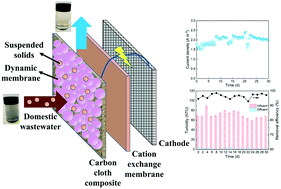Researchers generate electricity from wastewater, while cleaning it up
Published on by Water Network Research, Official research team of The Water Network in Case Studies
In a world starved of energy but brimming with people and the waste they produce, putting the waste to good use seems sensible. Take wastewater: the organic materials present in wastewater can be valuable sources of energy.
Researchers from Washington University in St. Louis have now developed a system to tap into that energy. They have made a device that produces electricity from wastewater while filtering it for non-potable use at the same time. The technology, detailed in the journal Environmental Science: Water Research & Technology , could enhance wastewater treatment and also make it energy-neutral, the researchers say.
Conventional wastewater treatment consumes a massive amount of energy. In the U.S., wastewater and drinking water plants use 3 to 5 percent of all electricity. Globally, wastewater plants also produce about 3 percent of greenhouse gas emissions, including carbon dioxide but also methane and nitrous oxide.
Recent efforts have attempted to reduce the energy footprint of wastewater systems. Researchers have showed that bacteria can convert sewage and wastewater into hydrogen fuels and bioplastics, for instance. Others have proposed simple, low-energy methods to remove polluting nitrogen and phosphorus from wastewater to repurpose into fertilizer.
Yet another way to generate energy from wastewater is to use a device called a microbial fuel cell, which uses bacteria to convert wastewater into electricity.
The new device is a spin on a microbial fuel cell with an advantage: it produces electricity but also usable water. Fuel cells are battery-like devices with two electrodes. The Washington University team made one electrode out of a carbon cloth. The cloth acts as a filter, collecting organic matter from the wastewater. Bacteria easily grow on the cloth, where they consume the organic materials and release electrons for electricity.
Discover more: Climate fiction shifts readers’ beliefs—but not for long
The water collected on the other side is clean enough for non-potable uses such as irrigation, or to be released into the environment.
In lab tests, the researchers fed the system with actual wastewater for a test period of 30 days, over which it worked effectively. They now aim to scale it up and test it in the real world.
Enhancing the performance of a microbial electrochemical system with carbon-based dynamic membrane as both anode electrode and filtration media†
Fubin Liu,  a Hanan Moustafa, b Mohammed Salah El-Din Hassouna b and Zhen He
a Hanan Moustafa, b Mohammed Salah El-Din Hassouna b and Zhen He  * a
* a
Abstract
Microbial electrochemical systems (MESs) can be incorporated with membrane filtration that assists the bioelectrochemical treatment. Herein, a dynamic membrane (DM) was created on the carbon cloth-based anode electrode in a dynamic membrane microbial electrochemical system (DMES) and evaluated for treating domestic wastewater. The advantage of this DMES was demonstrated via comparing to the one without DM filtration. It was found that DMES achieved a current density of 15.75 ± 0.86 A m−3 at 10 Ω, which is significantly higher than that of the control system with no DM filtration (6.60 ± 0.22 A m−3). Moreover, the DMES effluent had a turbidity of 11.1 ± 0.3–16.7 ± 0.5 NTU under the varied water fluxes, which is much lower than that from the control system (29.3 ± 0.8–34.8 ± 0.5 NTU). The use of a stainless-steel current collector as a part of DM could increase the current generation. However, adding one more layer of DM showed a limited improvement of the DMES performance at the expense of an additional capital cost. When fed with actual domestic wastewater for an extended operation for 30 days, DMES showed relatively stable treatment performance and was able to maintain turbidity lower than 5 NTU. This study has provided the initial results of employing the DM concept in the anode of an MES for enhanced treatment performance and electricity generation. Several challenges to be addressed were identified and discussed with further investigation.
Taxonomy
- Treatment
- Biological Treatment
- Biological Treatment
- Energy
- Renewable Energy
- water treatment
- Energy Reclamation
